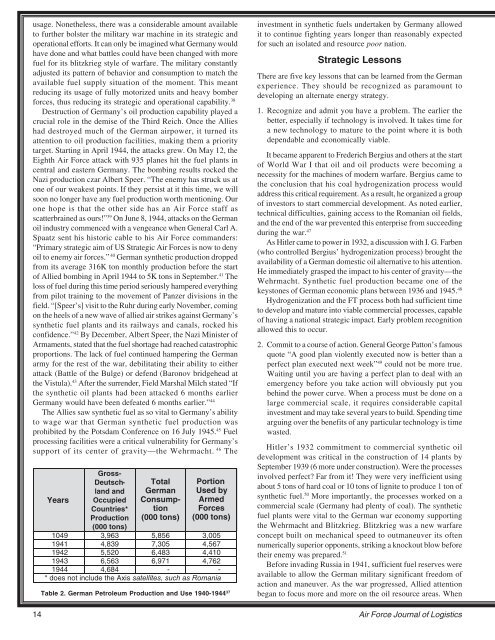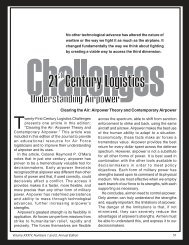Vol 32 No 4 - AF Logistics Management Agency
Vol 32 No 4 - AF Logistics Management Agency
Vol 32 No 4 - AF Logistics Management Agency
You also want an ePaper? Increase the reach of your titles
YUMPU automatically turns print PDFs into web optimized ePapers that Google loves.
usage. <strong>No</strong>netheless, there was a considerable amount available<br />
to further bolster the military war machine in its strategic and<br />
operational efforts. It can only be imagined what Germany would<br />
have done and what battles could have been changed with more<br />
fuel for its blitzkrieg style of warfare. The military constantly<br />
adjusted its pattern of behavior and consumption to match the<br />
available fuel supply situation of the moment. This meant<br />
reducing its usage of fully motorized units and heavy bomber<br />
forces, thus reducing its strategic and operational capability. 38<br />
Destruction of Germany’s oil production capability played a<br />
crucial role in the demise of the Third Reich. Once the Allies<br />
had destroyed much of the German airpower, it turned its<br />
attention to oil production facilities, making them a priority<br />
target. Starting in April 1944, the attacks grew. On May 12, the<br />
Eighth Air Force attack with 935 planes hit the fuel plants in<br />
central and eastern Germany. The bombing results rocked the<br />
Nazi production czar Albert Speer. “The enemy has struck us at<br />
one of our weakest points. If they persist at it this time, we will<br />
soon no longer have any fuel production worth mentioning. Our<br />
one hope is that the other side has an Air Force staff as<br />
scatterbrained as ours!” 39 On June 8, 1944, attacks on the German<br />
oil industry commenced with a vengeance when General Carl A.<br />
Spaatz sent his historic cable to his Air Force commanders:<br />
“Primary strategic aim of US Strategic Air Forces is now to deny<br />
oil to enemy air forces.” 40 German synthetic production dropped<br />
from its average 316K ton monthly production before the start<br />
of Allied bombing in April 1944 to 5K tons in September. 41 The<br />
loss of fuel during this time period seriously hampered everything<br />
from pilot training to the movement of Panzer divisions in the<br />
field. “[Speer’s] visit to the Ruhr during early <strong>No</strong>vember, coming<br />
on the heels of a new wave of allied air strikes against Germany’s<br />
synthetic fuel plants and its railways and canals, rocked his<br />
confidence.” 42 By December, Albert Speer, the Nazi Minister of<br />
Armaments, stated that the fuel shortage had reached catastrophic<br />
proportions. The lack of fuel continued hampering the German<br />
army for the rest of the war, debilitating their ability to either<br />
attack (Battle of the Bulge) or defend (Baronov bridgehead at<br />
the Vistula). 43 After the surrender, Field Marshal Milch stated “If<br />
the synthetic oil plants had been attacked 6 months earlier<br />
Germany would have been defeated 6 months earlier.” 44<br />
The Allies saw synthetic fuel as so vital to Germany’s ability<br />
to wage war that German synthetic fuel production was<br />
prohibited by the Potsdam Conference on 16 July 1945. 45 Fuel<br />
processing facilities were a critical vulnerability for Germany’s<br />
support of its center of gravity—the Wehrmacht. 46 The<br />
14<br />
Years<br />
Gross-<br />
Deutschland<br />
and<br />
Occupied<br />
Countries*<br />
Production<br />
(000 tons)<br />
Total<br />
German<br />
Consumption<br />
(000 tons)<br />
Portion<br />
Used by<br />
Armed<br />
Forces<br />
(000 tons)<br />
1049 3,963 5,856 3,005<br />
1941 4,839 7,305 4,567<br />
1942 5,520 6,483 4,410<br />
1943 6,563 6,971 4,762<br />
1944 4,684 - -<br />
* does not include the Axis satellites, such as Romania<br />
Table 2. German Petroleum Production and Use 1940-1944 37<br />
investment in synthetic fuels undertaken by Germany allowed<br />
it to continue fighting years longer than reasonably expected<br />
for such an isolated and resource poor nation.<br />
Strategic Lessons<br />
There are five key lessons that can be learned from the German<br />
experience. They should be recognized as paramount to<br />
developing an alternate energy strategy.<br />
1. Recognize and admit you have a problem. The earlier the<br />
better, especially if technology is involved. It takes time for<br />
a new technology to mature to the point where it is both<br />
dependable and economically viable.<br />
It became apparent to Frederich Bergius and others at the start<br />
of World War I that oil and oil products were becoming a<br />
necessity for the machines of modern warfare. Bergius came to<br />
the conclusion that his coal hydrogenization process would<br />
address this critical requirement. As a result, he organized a group<br />
of investors to start commercial development. As noted earlier,<br />
technical difficulties, gaining access to the Romanian oil fields,<br />
and the end of the war prevented this enterprise from succeeding<br />
during the war. 47<br />
As Hitler came to power in 19<strong>32</strong>, a discussion with I. G. Farben<br />
(who controlled Bergius’ hydrogenization process) brought the<br />
availability of a German domestic oil alternative to his attention.<br />
He immediately grasped the impact to his center of gravity—the<br />
Wehrmacht. Synthetic fuel production became one of the<br />
keystones of German economic plans between 1936 and 1945. 48<br />
Hydrogenization and the FT process both had sufficient time<br />
to develop and mature into viable commercial processes, capable<br />
of having a national strategic impact. Early problem recognition<br />
allowed this to occur.<br />
2. Commit to a course of action. General George Patton’s famous<br />
quote “A good plan violently executed now is better than a<br />
perfect plan executed next week” 49 could not be more true.<br />
Waiting until you are having a perfect plan to deal with an<br />
emergency before you take action will obviously put you<br />
behind the power curve. When a process must be done on a<br />
large commercial scale, it requires considerable capital<br />
investment and may take several years to build. Spending time<br />
arguing over the benefits of any particular technology is time<br />
wasted.<br />
Hitler’s 19<strong>32</strong> commitment to commercial synthetic oil<br />
development was critical in the construction of 14 plants by<br />
September 1939 (6 more under construction). Were the processes<br />
involved perfect? Far from it! They were very inefficient using<br />
about 5 tons of hard coal or 10 tons of lignite to produce 1 ton of<br />
synthetic fuel. 50 More importantly, the processes worked on a<br />
commercial scale (Germany had plenty of coal). The synthetic<br />
fuel plants were vital to the German war economy supporting<br />
the Wehrmacht and Blitzkrieg. Blitzkrieg was a new warfare<br />
concept built on mechanical speed to outmaneuver its often<br />
numerically superior opponents, striking a knockout blow before<br />
their enemy was prepared. 51<br />
Before invading Russia in 1941, sufficient fuel reserves were<br />
available to allow the German military significant freedom of<br />
action and maneuver. As the war progressed, Allied attention<br />
began to focus more and more on the oil resource areas. When<br />
Air Force Journal of <strong>Logistics</strong>





